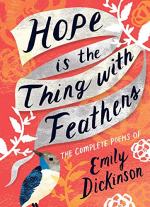|
This section contains 363 words (approx. 1 page at 400 words per page) |

|
Hope Is the Thing With Feathers Summary & Study Guide Description
Hope Is the Thing With Feathers Summary & Study Guide includes comprehensive information and analysis to help you understand the book. This study guide contains the following sections:
This detailed literature summary also contains Quotes and a Free Quiz on Hope Is the Thing With Feathers by Emily Dickinson.
The following version of this poem was used to create this guide: Dickinson, Emily. "Hope is the Thing with Feathers." Poetry Foundation Online. https://www.poetryfoundation.org/poems/42889/hope-is-the-thing-with-feathers-314.
Note that all parenthetical citations within the guide refer to the line number from which the quotation is taken.
“Hope is the thing with feathers” is a lyric poem split into three stanzas, written by American poet Emily Dickinson around 1861. Not much is known about the circumstances in which the poem was written because much of Dickinson’s life in Amherst, Massachusetts remains shrouded in mystery. She was considered eccentric and reclusive by her neighbors, shunned guests, and never married. Only ten of her 1,800 poems saw publication during her lifetime. “Hope” was first included in one of Dickinson's hand-sewn fascicles, and discovered again after her death by her sister Lavinia Dickinson. Subsequently, along with many of her other unpublished poems, “Hope” was published in 1891. Dickinson's cultural legacy in American literature and culture is prominent, inspiring poets in later generations as well as the construction of an Emily Dickinson Museum in 2003 in her honor.
Dickinson’s solitude was likely a reason for her prolific poetic output. Many of her poems deal with metaphysical themes such as death, hope, loneliness, eternity, and spirituality. She frequently drew on images and motifs that could be found in her immediate vicinity, such as gardens and flowers. She wrote in one her letters that “If I read a book and it makes my whole body so cold no fire can warm me, I know that is poetry.”
“Hope” is one of Dickinson’s more optimistic and life-affirming poems, as it portrays the persistent presence of hope in keeping the speaker going despite the vicissitudes and setbacks that she faces in her life. After setting up the metaphor of the bird in the first stanza, the speaker goes on to consider the qualities of the storm that might faze or deter the song of the bird. Finally, the speaker solidifies once again her faith in hope, explaining how it never abandons her even in the most difficult of circumstances, while never asking anything of her in return.
Read more from the Study Guide
|
This section contains 363 words (approx. 1 page at 400 words per page) |

|



